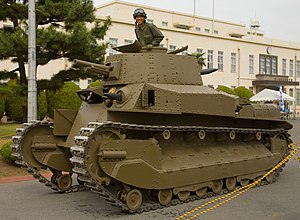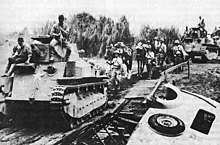Type 89 I-Gō
| Type 89 I-Gō | |
|---|---|

A Type 89 I-Gō, version B, during an exhibition at the Tsuchira Panzer Museum. |
|
| General properties | |
| crew | 4 (commander / gunner, loader, driver, bow machine gunner) |
| length | Tower 12 o'clock 5.73 m |
| width | 2.13 m |
| height | 2.56 m |
| Dimensions | 12.79 t - 14 t |
| Armor and armament | |
| Armor | 6-17 mm |
| Main armament | 57-mm type 90 cannon 100 rounds |
| Secondary armament | 2 × 6.5 mm Type 91 MG 2,745 rounds |
| agility | |
| drive | Air-cooled Mitsubishi A6120VD 6-cylinder diesel engine 90 kW (120 PS) |
| suspension | Leaf spring |
| Top speed | 26 km / h (road) |
| Power / weight | approx. 7.0 kW / t (9.4 PS / t) |
| Range | approx. 170 km |
The Type 89 "I-Gō" ( Japanese. 八九 式 中 戦 車 イ 号 , Hachikyū-shiki chū-sensha I-gō ) was a Japanese medium tank in the Second Sino-Japanese War and World War II , the 1929 ( Kōki 2589, hence the type designation) was used until 1945 in mechanized regiments and brigades of the Imperial Japanese Army as well as in some units of the special landing forces of the Imperial Japanese Navy . It was the world's first series-produced diesel-powered tank.
history
After the First World War , the Japanese army recognized the need to use armored vehicles to support their infantry . A British Mark IV was acquired in October 1918 to test the new branch of arms . In 1919 six British Mark A and 13 French Renault FT tanks were bought. Five of the latter vehicles made up the first Japanese Panzer Division, which was assigned to the 12th Division as the 1st Panzer Division in 1925 .
Based on the experience gained from testing the acquired tanks, the Imperial Japanese Army formulated a list of requirements for the first tank to be manufactured in Japan. The list was given to the 4th Military Research Laboratory of the Technical Bureau of the Imperial Japanese Army in Okubo District, which was responsible for developing new vehicles. The prototype resulting from the Osaka Arsenal in 1926 , the experimental tank No. 1 , had a main turret in the middle and a small turret on the front and rear of the tank. At 16.3 tons, it exceeded the required weight limit. Later went out this prototype heavy tank Type 91 and heavy tank Type 95 produced. In 1927 Vickers-Armstrongs Ltd. a prototype of the Vickers 6-ton model C acquired. During test drives, the Model C gasoline engine caught fire and the decision was made to use diesel engines in the future.
A new prototype was then created that met the weight requirements and was taken into service in 1929 as the Type 89 I-Gō (sometimes also called Type 89 Yi-Gō ). I-Gō means roughly "first model". The official name for the tank was Type 89 Chi-Ro , which means something like "Middle Second" in reference to "Medium Tank" and "Second Japanese Tank".
The Type 89 was produced in the Sagami Arsenal, but the limited production facilities there forced the Arsenal to outsource the manufacture of the tank to private companies. Mitsubishi Heavy Industries took over the contract and built a tank production facility for the Type 89 in the immediate vicinity of the Sagami Arsenal. The original design of the tank, which was called the Type 89A, was to use a 118 hp petrol engine. In 1934 the final engine, a 120 hp Mitsubishi diesel engine, was used and the name of the tank was changed to Type 89B Otsu . This made the Type 89B the world's first series-produced diesel-powered tank. In the course of production, the Type 89 experienced improvements that were gained from the experience of the fighting troops. So was z. B. changed the tower attachment for the commander from the shape of a hat to a separate entry / exit hatch and separate openings for air circulation. The front armor of the Type 89 was built completely at an angle in the B version and the turret received a tripod for a machine gun on the outside on the rear right side . The turret was given an asymmetrical shape designed to accommodate a rear-facing machine gun. If necessary, the Type 89 could turn the turret 180 ° and thus deploy two machine guns forward. From then on, the turret shape of the Type 89 became the model for many Japanese tanks.
In 1932 the First Battle of Shanghai took place , in which the 2nd Independent Tank Company under Captain Shigemi u. a. with five Type 89 participated. From 1933 the 1st Special Tank Company was also equipped with Type 89 tanks and took part in battles with Chinese national troops in Jehol Province in March 1933.
After winning the Russo-Japanese War of 1904/05, the Japanese Empire faced a growing Russian enemy and increased its military presence in Manchuria . For this purpose, the first three Japanese tank regiments were set up in 1933, some of which were equipped with Type 89. A total of 404 tanks of the Type 98 I-Gō were manufactured between 1931 and 1939, of which the majority (291 pieces) were for Version B.
Calls
China
The Type 89 proved itself in its first combat mission during the First Battle of Shanghai. During the Second Sino-Japanese War, it successfully fought enemy machine-gun nests and light tanks , mostly as infantry support . From 1935 it became apparent that the Type 89 did not have sufficient armor, as the national Chinese were meanwhile equipped with anti-tank rifles .
Japanese-Soviet border conflict
In 1939 the majority of the operational Type 89 tanks were stationed on the Chinese mainland. On July 2, 1939, the Japanese 1st Panzer Corps under General Yasuoka Masaomi with u. a. During the Japanese-Soviet border conflict, 34 Type 89 tanks were involved in fighting with Soviet tank formations consisting of T-26 and BT tanks . Although the 1st Panzer Corps was able to overrun the first Soviet line and achieve a deep break, they had to withdraw again. Exact numbers of casualties for the Type 89 tanks are not known, but there have been voices expressing concern about easy penetration of armor by Soviet 37 and 45 mm tank shells.
Second World War
From 1941 it became clear that the Type 89 was out of date. For lack of alternatives, he remained in service on the Chinese battlefield until the end of the war. He was also in action in 1941/42 in the Japanese invasion of the Philippines , the battle for Malaysia and the campaign in Burma .
From 1943 the Type 89 was mostly buried and used as a stationary tank bunker. In action against the M3 Stuart or M4 Sherman , the fatal inferiority of the Type 89 became apparent.
The last significant use of several Type 89 tanks took place in October 1944 during the Battle of Leyte , which posed no serious threat to the far superior Sherman tanks.
technology

Type 89A I-Gō (Chi-Ro)
The Type 89A had many of the characteristics of the Vickers 6-ton, starting with the bogie suspension of the lower eight wheels (two suspensions with four wheels each) supplemented with a ninth front wheel. All running wheels were mounted on leaf suspension . The chain was returned via five wheels. The rear wheel served as the drive wheel for the 118 hp petrol engine. Armored aprons were attached to both sides, most of which covered the wheels. The driver sat in the front left. To his right sat the bow machine-gunner who operated a Type 11 machine gun with a caliber of 6.5 mm. Another Type 91 MG was rear-facing in the turret. Both machine guns were protected by screens and together carried 2745 rounds. The armor consisted of steel plates made by the Nihon Seikosho Company (JSW), which were relatively thin at 6-17 mm. The tower had a conical shape with a hat-like attachment that gave the commander a view and was used for air circulation. The turret was equipped with a Type 90 57 mm chariot gun, for which 100 rounds could be carried. The swivel range of the 83 cm long cannon ranged from −15 ° to + 20 °. The muzzle velocity was 380 m / s, which was sufficient to penetrate 20 mm thick armor at a distance of 500 meters. The crew consisted of four men (commander, loader, driver, bow machine gunner), with the commander also being a gunner. Some Type 89 had two headlights for night operations and / or were equipped with a Type 94 mk.4 radio.
Type 89B Otsu
The Type 89B differed from the A-Model in many details. The weight increased to 14 tons, which was partly due to the replacement of the engine with a 120 hp air-cooled Mitsubishi A6120VD 6-cylinder diesel engine. The more powerful engine gave the Type 89 a higher speed and higher output. The use of the diesel engine reduced the risk of fire, increased speed and range. Furthermore, the front area was built completely at an angle and the driver and bow machine gunner swapped places. The tower was given its asymmetrical shape, which is characteristic of Japanese tanks, and instead of the "hat" was given a mushroom-shaped dome with a two-door hatch. The front and rear wheels got bigger teeth to guarantee a higher grip. The upper wheels were reduced to four. The cannon was replaced by the more powerful Type 97 57 mm version, which had a longer barrel and greater penetration.
Preserved copies

- in the United States Army Ordnance Museum on the Aberdeen Proving Ground ( Maryland )
- at the Tsuchira Tank Museum of the Ground Self-Defense Forces in Tsuchiura , Japan .
- at Sinbudai Old Weapon Museum , Camp Asaka, Japan
Web links
- Type 89 Yi-Go / Chi-Ro. Tanks Encyclopedia, accessed December 4, 2014 .
- The Development of Imperial Japanese Tanks. Taki's Page, accessed December 4, 2014 .
- Estudiando a los blindados japoneses (study of Japanese tanks). Foro Segunda Guerra Mundial (Forum Second World War), accessed December 4, 2014 . Spanish
literature
- Steven J Zaloga: "Japanese Tanks 1939-45" Osprey Publishing, 2007, ISBN 978-1-84603-091-8 .



